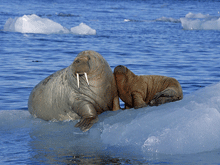Arctic sea ice melting, which scientists have linked to global warming, may be a boon for the shipping industry. As the sea ice continues to melt a shipping passage to Russia's north is becoming more navigable, and now two German ships are close to completing the first trip from Asia to Europe via the Arctic shortcut. However, walruses that live in the Arctic could care less, since their sea ice habitat is rapidly disappearing. Thousands of walruses are congregating on Alaska's northwest coast, a sign that their Arctic sea ice environment has been altered by climate change. Chad Jay, a U.S. Geological Survey walrus researcher, said Wednesday that about 3,500 walruses were near Icy Cape on the Chukchi Sea, some 140 miles southwest of Barrow
[AP]
. Walruses wear themselves out diving for clams, and need to rest on the sea ice between meals. Since the sea ice is disappearing, ...














